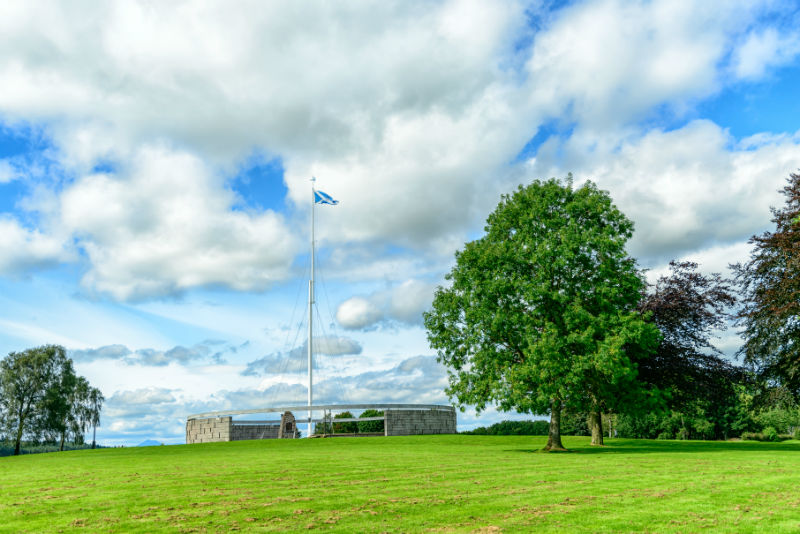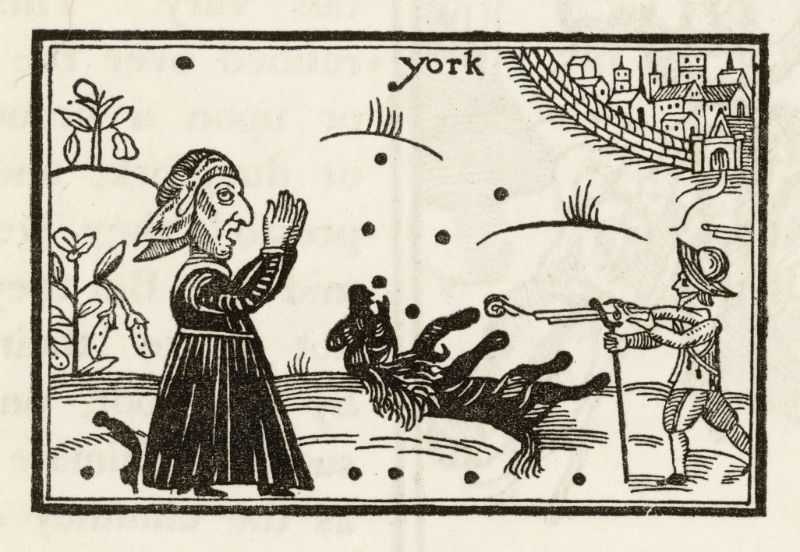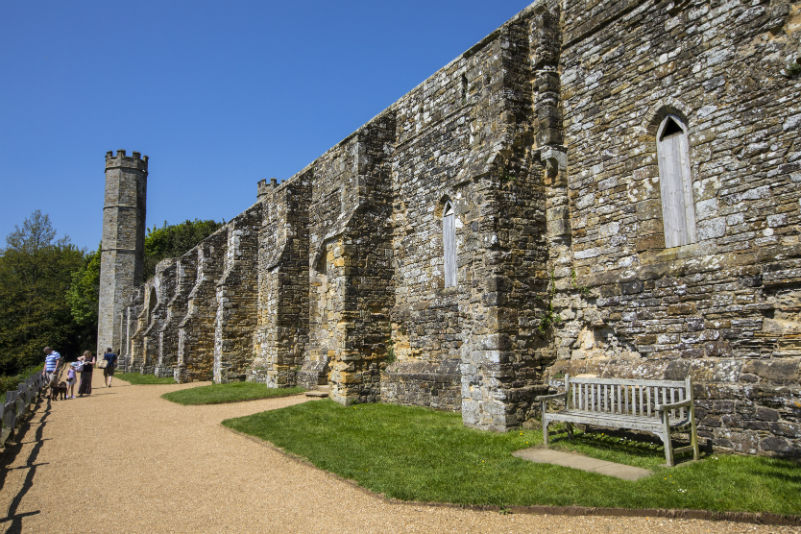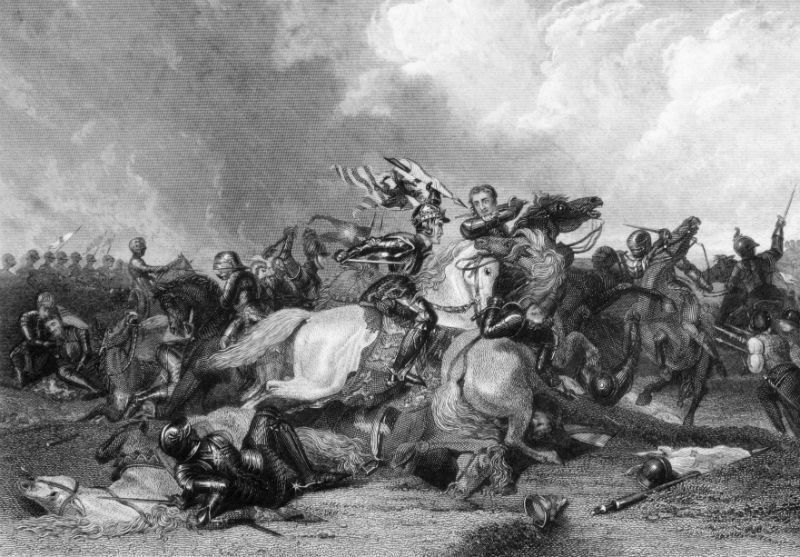Camping Inspiration: Camping near battlefields
Britain’s rich and varied history has seen much in the way of conflict over the centuries.
From the Roman era to the Jacobite rebellions, the bloody battles fought on our soil have helped shaped the nation and in many cases their impact is still being felt today.
Battles like Hastings, Bannockburn and Bosworth Field are well-known, but there are many others that are less famous but are equally worth visiting.
In fact there is estimated to be around 500 battlefields in Britain that you can visit. Many have visitor centres and offer guidebooks, audio and visual displays to let you relive the fighting. At others there may be a simple monument to mark the spot and you will have to do your own research before you arrive. In some cases a battlefield site may be no more than a farmer’s field or two on a bit of elevated moorland.
Some are paid attractions and others are free to visit, but no matter what form they take, visiting historic battlefields is fascinating and very absorbing. Let’s face it, it’s only when you have walked the ground where the fighting took place that you can fully appreciate what happened and find out more about Britain’s horrible history.
CULLODEN
Culloden Moor is located near Inverness in the north of Scotland. It was on this remote moorland in 1746 that the final Jacobite rising came to a head in a violent clash that turned out to be the last pitched battle to take place on British soil. The Duke of Cumberland’s Government troops fought the Jacobite supporters who were seeking to restore the Stuart monarchy to the throne of Britain. In less than an hour 1,600 men were dead, with 1,500 of them being Jacobites. Today you can relive this conflict at a paid attraction that welcomes hundreds of visitors most days of the year. There is a visitor centre beside the battlefield, a shop selling battlefield prints, jewellery crafted from the flowers of the battlefield and even Culloden whisky. You can see the battle recreated in the visitor centre’s 360 degree immersion theatre where you will feel as though you are right in the centre of the battle as it took place. You can even join a guided tour of the battlefield where an expert will take you around and point out what happened where.
STAY AT
CULLODEN MOOR CARAVAN AND MOTORHOME CLUB SITE
Newlands, Culloden Moor, Inverness IV2 5EF
01463 790625
caravanclub.co.uk
.jpg)
BANNOCKBURN
One of the most famous military clashes to take place on this island, the Battle of Bannockburn was fought in June 1314 and was part of the first war of Scottish independence. With Stirling Castle as the backdrop, two opposing kings, Robert the Bruce of Scotland and Edward II of England, came face to face and fought a bloody and brutal battle. Bruce’s army was heavily outnumbered but he fought a clever tactical battle and forced Edward to surrender. The victory at Bannockburn is the most celebrated military triumph in Scottish history, has made Bruce a national hero and has been commemorated down the centuries in art and verse. Today the National Trust for Scotland operates the Bannockburn Visitor Centre and it is one of the most popular places to visit in this area of Scotland. At the visitor centre a series of immersive 3D films take you through the events leading up to, and during, the battle. After this you can visit the battle room where you can take part in an interactive game to try out your own battling skills. There is also a shop and café, a commemorative area and memorial cairn, plus a statue of Robert the Bruce.

Courtesy of Adobe Stock Images
STAY AT
WITCHES CRAIG CARAVAN AND CAMPING PARK
Blairlogie, Stirling FK9 5PX
01786 474947
witchescraig.co.uk
FLODDEN FIELD
Flodden Field is a battlefield on the slopes of Branxton Hill in Northumberland. It was the site of a major engagement between the Scottish and English on 9 September 1513. The battle came about as a result of King Henry VIII’s rejection of King James IV of Scotland’s ultimatum to withdraw his troops from his invasion of France or Scotland would invade England. Things quickly escalated and an estimated 60,000 Scottish troops crossed the border and the River Tweed into England. They set up camp on the high ground of Flodden Edge, an impressive feature rising some 600ft above the surrounding area. Despite the Scots seeming to hold the advantage, the Earl of Surrey marched an army to engage them two days later. The battle began in the late afternoon and only lasted around three hours, but by nightfall King James and around 10,000 of his troops lay dead. The English troops lost some 1,500 men during the battle. The final estimation of Scottish losses ranges from 10,000 up to 17,000. Today the battlefield is marked by a granite cross which was erected in 1910. There is also a battlefield trail created and maintained by the Remembering Flodden project.
STAY AT
HIGHBURN HOUSE CAMPSITE
Burnhouse Road, Wooler, Northumberland NE71 6EE
01668 281344
highburn-house.co.uk
SHREWSBURY
The Battle of Shrewsbury was a precursor to the Wars of the Roses and was fought in September 1403 between King Henry IV and a rebellious faction led by the powerful Percy family, under the command of Sir Henry “Hotspur” Percy. King Henry had gained the throne of England with the assistance of the Percy family but the relationship between the family and the king was never an amicable one and by 1403 it had all but broken down. The two armies met just north of Shrewsbury and the ensuing battle was significant as it was the first time the longbow was deployed in a battle fought on British soil. King Henry IV was victorious and Henry Hotspur was slain. The 100-hectare battlefield remains undeveloped farmland and is now enclosed by hedges. The Battlefield Church was built a few years after the battle at the behest of King Henry “for the souls of those who fell” and is said to be over the site of a mass burial pit. Access to the battlefield is via fenced footpaths laid out in circular route around it and there is a viewing mound and a car park. The site also has a battle exhibition, a café and a farm shop.
STAY AT
EBURY HILL CAMPING AND CARAVANNING CLUB SITE
Ring Bank, Haughton, Shrewsbury SY4 4GB
01743 709334
campingandcaravanningclub.co.uk
GLENCOE
The site of the massacre of Glencoe is not technically a battlefield but is an important location in Scottish military and feudal history. It took place beneath the brooding mountains of Glencoe in February 1692. Although popular history has transformed the massacre into something done to the Clan MacDonald by the Campbells, it was in fact undertaken by 130 government troops who were billeted with the MacDonalds. The soldiers were ordered to turn on their hosts because the MacDonalds had not been prompt enough in pledging allegiance to King William III of England. The orders arrived on 12 February and the massacre took place early the next morning. There was little mercy shown and initially around 38 MacDonalds were killed, but the sound of gunfire alerted most of the rest of the clan who fled into the bitter winter mountains, where it is likely twice as many more died from exposure. Today a modern visitor centre (close to the actual massacre site) has displays on the massacre and on Glencoe as a whole. A drive up the glen is also recommended to view the hostile terrain.
STAY AT
GLENCOE CAMPING AND CARAVANNING CLUB SITE
Ballachulish, Argyll, Near Glencoe PH49 4LA
01855 811397
campingandcaravanningclub.co.uk
.jpg)
MARSTON MOOR
The Battle of Marston Moor took place in the evening of 2 July 1644 and is believed to be the largest battle ever fought on British soil. It was an English Civil War battle that would decide who controlled York and the northern reaches of England. The royalist forces under Price Rupert numbered 18,000 and the Parliamentarian forces under Alexander Leslie, the Earl of Leven, numbered 28,000. Oliver Cromwell enhanced his reputation as a great commander during the fighting and the outcome was a victory for the Parliamentarians, who began to realise afterwards that a well-equipped, trained and determined army could win the Civil War as this was the first major royalist defeat on the two-year-long fighting. The battlefield sites remain agricultural but are now fully enclosed – the villages of Long Marston and Tockwith have probably expanded a little, however. The road between these two villages runs across the centre of the battlefield, as it did in 1644, so you can observe where the fighting took place. Halfway along the road you will find a monument and several information boards near a layby. A lane runs north from the monument and this is often used to gain access to the former moor edge, where the first engagement took place.

Courtesy of Adobe Stock Images
STAY AT
RUDDING HOLIDAY PARK
Follifoot, Harrogate, North Yorkshire HG3 1JH
01423 870439
ruddingholidaypark.co.uk
HASTINGS
The Battle of Hastings, on 14 October 1066, is arguably the best-known British battle. William of Normandy thought he was the heir to the English crown and when he heard of Harold Godwinson’s accession to the throne he decided to take it by force rather than wait any longer. He landed his army on the beach at Pevensey. King Harold had been in action already in Yorkshire battling a Norwegian invasion but on hearing the news he was forced to march his army south to face William. Arriving exhausted by the long march on 14 October he took up a defensive position on Senlac Ridge which was located where present day Battle is. The English fought on foot in tightly packed ranks while William’s army was made up of both foot soldiers and mounted knights. After numerous Norman attacks the English forces were worn down by William’s archers and his shock tactics. The English line broke and King Harold was hacked to death. Today the visitor centre (fee to enter) at Battle offers audio battlefield tours and information boards, a Norman and Saxon sculpture trail, a walled garden and a chance to visit the ruins of the abbey, which was founded at William’s expense to atone for the battlefield slaughter.

Courtesy of Adobe Stock Images
STAY AT
THE SECRET CAMPSITE (BEECH ESTATE)
B2096 Kane Hythe Road, Battle, East Sussex TN33 9QU
01273 980218
thesecretcampsites.co.uk/beech-estate
.jpg)
STOW-ON-THE-WOLD
The battle of Stow-on-the-Wold took place a mile north of the town during the early morning of 21 March 1646. It was to be the final battle of the English Civil War and was fought between a royalist force of around 3,000 troops and a Parliamentarian of around 3,000 to 3,500 troops. The royalist army was commanded by Sir Jacob Astley and the Parliamentarian forces were under the command of Colonel Thomas Morgan. The outcome was a victory for the Parliamentarians. It was a very short battle fought in open farmland and in some streets of Stow-on-the-Wold as the retreating Royalists were pursued by the Parliamentarians into the town before Sir Jacob Astley surrendered in the town’s market square. The royalist cause came to an end at the Battle of Stow-on-the-Wold with the destruction of their final field army and the outcome of the battle signalled the end of the English Civil War. The traditional battle site is on a ridge to the west of the village of Donnington. Access to most areas of the battlefield is available via public rights of way and by roads across the battlefield itself. There is a memorial stone to the battle victims in the town church. Sir Jacob Astley surrendered at the base of the cross in the town square.
STAY AT
FOLLY FARM CARAVAN AND CAMPING SITE
Borton-on-the-Water, Near Cheltenham, Gloucestershire GL54 3BY
01451 820285
cotswoldcamping.net
BOSWORTH FIELD
The Battle of Bosworth Field was the last significant battle of the Wars of the Roses and was fought in August 1485. The battle lasted just two hours but it remains one of the best-known battles fought on British soil. It was certainly one of the most influential, as it saw one of the most dramatic military reversals recorded in English history. The royalist army under King Richard III numbered somewhere between 10,000 and 15,000 men and the rebel army under Henry Tudor (but really under the command of the Earl of Oxford) numbered a lot fewer at around 5,000. Despite being outnumbered, the rebels won the battle and Richard III (the last Plantagenet king) was killed, making him the last English king to die on the battlefield. This event placed Henry VII on the throne of England and he became the first monarch of the new Tudor dynasty. Today you can visit Bosworth Battlefield Heritage Centre which is a paid attraction. Here you will find a museum with a hands-on gallery and displays. There are also attractions for children and guided battlefield walks.

Courtesy of Adobe Stock Images
STAY AT
BOSWORTH WATER PARK CAMPING SITE
Wellsborough Road, Market Bosworth, Nuneaton, Warwickshire CV13 6PD
01455 291876
bosworthwatertrust.co.uk
.jpg)
MONTGOMERY CASTLE
Despite being the biggest battle fought on Welsh soil during the English Civil War, it’s not a particularly well-known encounter. However, it is quite an enjoyable battlefield to visit and look around. The Battle of Montgomery was fought on 18 September 1644 and followed on from the catastrophic royalist defeat at Marston Moor. After this, Parliamentary forces went on the offensive in the Welsh Marches and in September 1644 they captured the strategically important Montgomery Castle. A good-sized royalist army was sent to recapture the castle under the command of Lord Byron. With about 4,500 men they surrounded the castle and lay siege to it. However, on 17 September a Parliamentarian relief force arrived and the battle saw the Royalists defeated. Today, a footpath leads off Offa’s Dyke long-distance footpath to what is believed to be the centre of the action. The ruins of Montgomery Castle are well worth climbing to as the views are superb.
STAY AT
FOXHOLES CASTLE CAMPING
Fox Holes, Montgomery Road, Bishops Castle, Shropshire SY9 5HA
01588 638924
foxholes-castle.co.uk
Words and pics by Steve Goodier






.JPG)
.JPG)
.JPG)
.JPG)
.JPG)
.JPG)


Recent Updates
Our family camping checklist: everything you need to pack
Sure, you’ve packed the tent and the sleeping bags – but what about slip-on shoes and glow sticks? These are the family camping essentials that you ...
Our guide to planning the perfect camping road trip
Roll down the window, pop on those shades and crank up the volume – it’s time for a road trip. Get ready for ...
Camping in Europe: our 12 top tips
If you’ve not camped in Europe before, there’s a few tips and tricks you’ll need to avoid some continental ...
Solar power for camping: all you need to know
Staying connected in the great outdoors is easier than ever with a solar charger – or is it? How reliable are ...
Wild camping kit list: everything you need for your next adventure
Make sure you’re ready for anything with this list of lightweight camping gear and clothing, including ...
Camping furniture: all you need to know to make your tent a cosy haven
We delve into the essentials of camping chairs, camping tables, and kitchen and bedroom furniture, ensuring ...
Camping lights for tents: What you need to know
We will guide you through all the lighting options available for you and your tent, including interior ...
Camping kitchen: all you need to know
In the great outdoors, a well-equipped camping kitchen transforms mealtime into a delightful adventure ...
How to pack away your camping gear for winter
A complete guide to packing and storing your gear at the end of the season ...
Camping guide to trailers
Trailer stash or trailer trash? Being able to carry lots of other gear when you go camping isn’t such a bad ...
Other Articles
Winter camping: all you need to know to keep warm
Winter doesn’t have to mean the end of the camping season. With good preparation and the right gear, there’s no reason why you can’t camp all year ...
Camping toilets: a complete guide
If you are wild camping, camping off-grid or the campsite you book onto doesn’t have toilet facilities, you ...
Top tips for camping in windy weather
How to make sure your tent stands up to gusty conditions ...
Camping tents: a complete guide
If you're considering buying a camping tent, whether it's your first time or you're a seasoned camper, making ...
Camping sleeping bags and beds: a complete guide
When it comes to camping, there's one essential item that can make or break your outdoor adventure: the ...
Camping gas: how to use gas on the campsite
A complete guide to using camping gas appliances safely on the campsite, from choosing the right stove to ...
Camping storage: a complete guide
Having problems knowing where to put all your gear when you're camping? Read our top tips and see some great ...
Camping electric hook-up: a complete guide
This is everything you need to know about using electricity on a campsite, including how to hook up ...
How to pack all your camping gear into your car
Planning a family camping holiday? Find out the best way to fit all the kit you need into your car boot, roof ...
Camping stoves and cookers: the complete guide
Camping stoves are an essential part of any outdoor adventure, allowing you to prepare meals and hot drinks ...